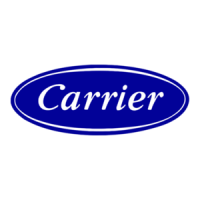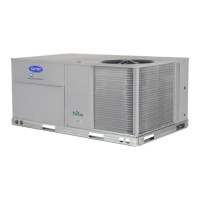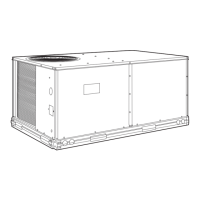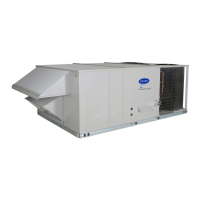30
SELECTION PROCEDURE (WITH 50TC*A07 EXAMPLE)
I. Determine cooling and heating loads.
Given:
Mixed Air Drybulb 80_F(27_C)
Mixed Air Wetbulb 67_F(19_C)
Ambient Drybulb 95_F(35_C)
TC
Load
69.0 MBH
SHC
Load
51.0 MBH
Vertical Supply Air 2100 CFM
External Static Pressure 0.66 in.wg
Electrical Characteristics 230--3--60
II. Make an initial guess at cooling tons.
Refrig. tons = TC
Load
/ 12 MBH per ton
Refrig. tons = 69.0 / 12 = 5.75 tons
In this ca se, start by looking at the 50TC*A07.
III. Look up the rooftop’s TC and SHC.
Table 12 shows that , at the application’s supply air
CFM, mixed air and ambient temperatures, the
50TC*A07 supplies:
TC
Load
= 73.7 MBH
SHC
Load
= 54.4 MBH.
IV. Calculate the building Latent Heat Load.
LC
Load
=TC
Load
-- S H C
Load
LC
Load
= 69.0 MBH -- 51.0 MBH = 18.0 MBH
V. Calculate RTU Latent Heat Capacity
LC = TC -- SHC
LC = 73.7 MBH -- 54.4 MBH = 19.3 MBH
VI. Compare RTU capacities to loads.
2,3
Compare the rooftop’s SHC and LC t o the building’s
Sensible and Latent Heat Loads.
VII. Select factory options (FIOP)
Local code require s an economize r for any unit with
TC larger than 65.0 MBH.
VIII. Calculate the total static pressure.
External static pressure 0.66 in. wg
Sum of FIOP/Accessory static +0.14 in.
wg
Total Static Pressure 0.80 in. wg
IX. Look up the Indoor Fan RPM & BHP.
Table 33 shows, at 2100 CFM & ESP= 0.8,
RPM = 1268 & BHP = 1.52
X. Determine electrical requirements
Table 52 shows the MCA and MOCP of a
50TC*A07 (without c onvenience outlet) as:
MCA = 30.5 amps & MOCP = 45 amps
Min. Disconnect Size: FLA = 30 & LRA = 157.
LEGEND
BHP — Break horsepower
FLA — Full load amps
LC — Latent capacity
LRA — Lock rotor amp
MBH — (1,000) BTUH
MCA — Min. circuit ampacity
MOCP — Max. over --- current protection
RPM — Revolutions per minute
RTU — Rooftop unit
SHC — Sensible heat capacity
TC — Total capacity
NOTES:
1. Selection software by Carrier saves time by performing
many of the steps above. Contact your Carrier sales rep-
resentative for assistance.
2. Selecting a unit with a SHC slightly lower than the
SHC
Load
is often better than oversizing. Slightly lower
SHC’s will help control indoor humidity , and prevent tem-
perature swings.
3. If the rooftop’s capacity meets the Sensible Heat Load,
butnottheLatentHeatLoad.
4. Indoor Fan Motor efficiency is available in Table 46. Use
the decimal form in the equation eg. 80% =.8.
50TC
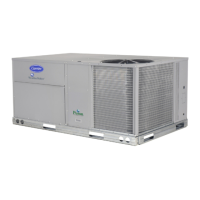
